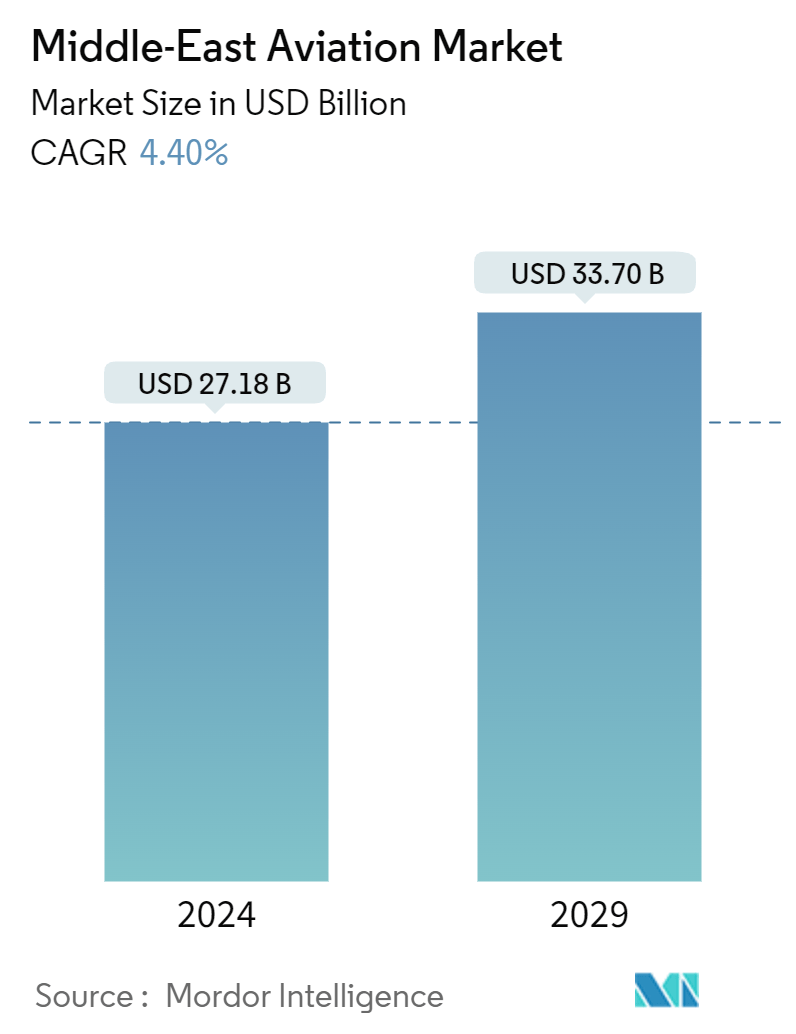Market Size of Middle-East Aviation Industry

| Study Period | 2019 - 2029 |
| Base Year For Estimation | 2023 |
| Market Size (2024) | USD 27.18 Billion |
| Market Size (2029) | USD 33.70 Billion |
| CAGR (2024 - 2029) | 4.40 % |
| Market Concentration | Medium |
Major Players
*Disclaimer: Major Players sorted in no particular order |
Middle-East Aviation Market Analysis
The Middle-East Aviation Market size is estimated at USD 27.18 billion in 2024, and is expected to reach USD 33.70 billion by 2029, growing at a CAGR of 4.40% during the forecast period (2024-2029).
The aviation market in the Middle East is dynamic and multifaceted, characterized by a unique blend of opportunities. The market’s growth in the region is driven by several factors, including the strategic geographical location of the region, which serves as a global transit hub, and the presence of some of the world's leading airlines, such as Emirates, Etihad, and Qatar Airways.
Commercial aviation, which holds the largest market share, was significantly impacted by international travel restrictions due to the COVID-19 pandemic. However, demand increased as new budget carriers emerged and existing airlines expanded their fleets. The general aviation sector is experiencing rapid recovery, buoyed by the high demand for private travel and the presence of many high-net-worth individuals in the region. This segment is seeing a growing preference for business jets and helicopters, catering to the luxury travel needs of the affluent population.
Military aviation remains robust, with countries in the Middle East continuing their procurement plans without significant delays. The segment is expected to grow substantially due to various combat aircraft procurement plans by nations such as the UAE, Saudi Arabia, Qatar, and other countries. This indicates the region's focus on enhancing its defense capabilities amid ongoing geopolitical tensions.
Despite these growth prospects, the Middle Eastern aviation market faces several restraints. Political instability in the region can create uncertainty, impacting market dynamics and growth. However, the opportunities in the Middle Eastern aviation market are abundant, as the region is expected to see an increase in its share of the global fleet over the next decade. Furthermore, the shift toward sustainable aviation presents opportunities for innovation and growth.
Middle-East Aviation Industry Segmentation
The Middle Eastern aviation market encompasses the sales of fixed-wing and rotary-wing aircraft across the commercial, military, and general aviation sectors in the Middle East. The market offers an overview of air passenger traffic, aircraft orders and deliveries, defense spending analysis, the introduction of new routes, and investments by country in the aviation sector in the region.
The Middle Eastern aviation market is segmented by application and geography. By application, the market is segmented into commercial, military, and general aviation segments. The commercial aircraft segment is further segmented into passenger aircraft and freighter. The military aircraft segment is further segmented into combat and non-combat aircraft. The general aviation segment is further segmented into helicopters, turboprop aircraft, piston fixed-wing aircraft, and business jets. The report also offers the market size and forecasts for five countries across the region. For each segment, the market sizing and forecasts were made based on value (USD).
| By Application | ||||||
| ||||||
| ||||||
|
| By Geography | |
| Saudi Arabia | |
| United Arab Emirates | |
| Qatar | |
| Israel | |
| Turkey | |
| Rest of Middle East |
Middle-East Aviation Market Size Summary
The Middle East aviation market is a dynamic and evolving sector, characterized by its strategic geographical position as a global transit hub and the presence of major airlines like Emirates, Etihad, and Qatar Airways. The market is experiencing growth driven by the recovery of commercial aviation, which was significantly impacted by the COVID-19 pandemic. The emergence of new budget carriers and the expansion of existing airline fleets have contributed to this recovery. Additionally, the general aviation sector is witnessing rapid growth due to high demand for private travel among the region's affluent population, with a growing preference for business jets and helicopters. Military aviation remains robust, with countries in the region continuing to invest in combat aircraft procurement to enhance their defense capabilities amid geopolitical tensions. Despite challenges such as political instability, the market presents abundant opportunities, particularly with the shift towards sustainable aviation.
The commercial aviation segment is expected to see increased demand due to rising air passenger traffic, new aircraft procurement, and improving economic conditions across the Middle East. The region's low domestic travel presence and major global hubs like Dubai facilitate the use of widebody aircraft. Airlines are expanding their fleets and introducing new routes to meet the growing demand, which is expected to drive the need for commercial aircraft engine maintenance, repair, and overhaul services. Saudi Arabia plays a significant role in the market, with substantial investments in airport infrastructure and fleet expansion, driven by the government's Vision 2030 initiative. The military aviation sector in Saudi Arabia is also experiencing growth, with increased acquisitions driven by regional rivalries. The market is semi-consolidated, with key players like Lockheed Martin, Boeing, and Airbus dominating, while emerging players from Turkey are expected to gain market share. The region's demand for business jets is anticipated to intensify competition among market players in the coming years.
Middle-East Aviation Market Size - Table of Contents
-
1. MARKET DYNAMICS
-
1.1 Market Overview
-
1.2 Market Drivers
-
1.3 Market Restraints
-
1.4 Industry Attractiveness - Porter's Five Forces Analysis
-
1.4.1 Bargaining Power of Buyers/Consumers
-
1.4.2 Bargaining Power of Suppliers
-
1.4.3 Threat of New Entrants
-
1.4.4 Threat of Substitute Products
-
1.4.5 Intensity of Competitive Rivalry
-
-
-
2. MARKET SEGMENTATION
-
2.1 By Application
-
2.1.1 Commercial Aircraft
-
2.1.1.1 Passenger Aircraft
-
2.1.1.2 Freighter
-
-
2.1.2 Military Aircraft
-
2.1.2.1 Combat Aircraft
-
2.1.2.2 Non-combat Aircraft
-
-
2.1.3 General Aviation
-
2.1.3.1 Helicopter
-
2.1.3.2 Piston Fixed-wing Aircraft
-
2.1.3.3 Turboprop Aircraft
-
2.1.3.4 Business Jet
-
-
-
2.2 By Geography
-
2.2.1 Saudi Arabia
-
2.2.2 United Arab Emirates
-
2.2.3 Qatar
-
2.2.4 Israel
-
2.2.5 Turkey
-
2.2.6 Rest of Middle East
-
-
Middle-East Aviation Market Size FAQs
How big is the Middle-East Aviation Market?
The Middle-East Aviation Market size is expected to reach USD 27.18 billion in 2024 and grow at a CAGR of 4.40% to reach USD 33.70 billion by 2029.
What is the current Middle-East Aviation Market size?
In 2024, the Middle-East Aviation Market size is expected to reach USD 27.18 billion.

